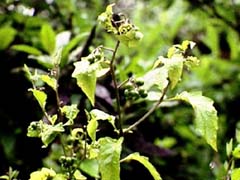Solanum sp:
Nightshades (various)
Solanaceae (Nightshade Family)
Flowers: White to white-lavender to pink/blue, with yellow centers; five petals sometimes bent back tomato-like, in branched or single loose racemes or umbels.
Blooms: February - October.
Leaves: Triangular, gently lobed or toothed, sometimes smooth; in pairs.
Fruit/Seeds: Small green - black balls.
Location: All trails and areas.
Status: Alien Inavsive or Native - Common.
CAUTION: These plants are POISONOUS
Solanum sp
Note the swept back petals, with distinct lavender marks and yellow centers on clustered flowers; this could be S. furcatum with a different coloring variation, or it might not.
600x450 JPEG - 36K
The Native and Alien species of nightshade are very similar. Patches near residential areas are very often one of the european varieties.
- Solanum americanum (Smallflower Nightshade) (Alien) has very small flowers (3 - 6 mm wide) and glossy fruit;
- Solanum douglasii (Douglas Nightshade) (Native) has larger flowers that do not fold back;
- Solanum nigrum (Black Nightshade) (Alien) has shorter anthers and is a smaller plant;
- Forked Nightshade (S. furcatum) (Alien) usually has a branched inflourescence with 2 umbel-like flower clusters;
- Hairy Nightshade (S. sarrachoides) (Alien) is , well, hairy with yellow fruit.
Image above shows distinct lavender/pink flower coloration, along with smooth leaves. This variety, whatever it is, is very susceptible to the mold-like growth seen in this image.
